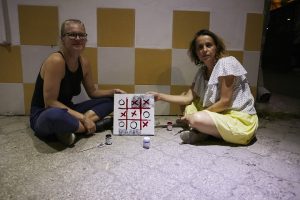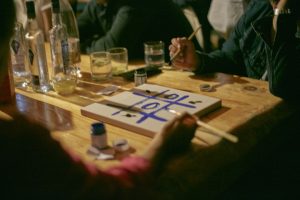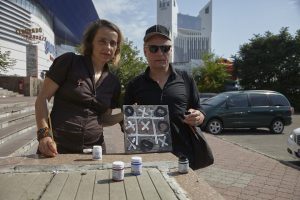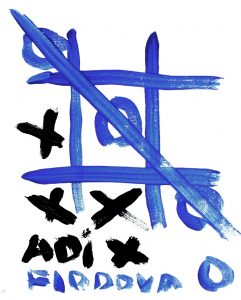 Tatiana Fiodorova is based, in Chisinau, Republic of Moldova. She works with installation, live performance, public art, video and artists’ books. The subject matter of her practice tends to reflect the contemporary world in response to current social, political and aesthetic issues. Fiodorova’s work has been shown at Biennial of contemporary photography and moving image, Iasi, Romania(2016), The Delhi Photo Festival(2015); the parallel programme of the Moscow Biennale of Contemporary Art (2015); Salonul de proiecte at Viennafair (2013); Torino PERFORMANCEART (2013), IDFF CRONOGRAF international documentory film festival, Chisinau(2013), Lago Film Festival International Festival of Short Films, Documentaries and Screenplays in Italy (2012), Moscow Biennale of Contemporary Art (2011); “Atlantis 11” at the Venice Biennale 2011,Kunst- und Kulturfestival in Berlin (2011), International Festival EXCHANGE RADICAL MOMENTS Live Art Festival London-Linz-Chisinau-Paris (2011), Periferic 8: The Romanian Biennial for Contemporary Art (2008)
Tatiana Fiodorova is based, in Chisinau, Republic of Moldova. She works with installation, live performance, public art, video and artists’ books. The subject matter of her practice tends to reflect the contemporary world in response to current social, political and aesthetic issues. Fiodorova’s work has been shown at Biennial of contemporary photography and moving image, Iasi, Romania(2016), The Delhi Photo Festival(2015); the parallel programme of the Moscow Biennale of Contemporary Art (2015); Salonul de proiecte at Viennafair (2013); Torino PERFORMANCEART (2013), IDFF CRONOGRAF international documentory film festival, Chisinau(2013), Lago Film Festival International Festival of Short Films, Documentaries and Screenplays in Italy (2012), Moscow Biennale of Contemporary Art (2011); “Atlantis 11” at the Venice Biennale 2011,Kunst- und Kulturfestival in Berlin (2011), International Festival EXCHANGE RADICAL MOMENTS Live Art Festival London-Linz-Chisinau-Paris (2011), Periferic 8: The Romanian Biennial for Contemporary Art (2008)
TIC-TAC-TOE
The project Tic-Tac-Toe is a performative painting, built on the popular game “Tic-Tac-Toe.” The artist invites different cultural figures, artists, curators, critics, musicians, and philosophers to play together on the basis of subjective preferences and closeness of views and common themes for the possibility to translate the game into verbal dialogue.
Andrei Nacu / Tatiana Fiodorova


Tatiana Fiodorova in conversation with Andrei Nacu
Tatiana Fiodorova / At first time I saw your work in the Photo Biennale in Iasi in 2016, where we both participated. I was interested in your method of working with photo archives. Tell me how and where do you find photos? Why do you use archival photos in your research? Andrei Nacu / After I’ve finished a photobook project about my parents, in which I’ve used both, photographs taken by me and images from our family album, I felt the need to expand my area of interest, studying family photography and its influence on the construction of the public memory. So, for the last couple of years, I have collected family photographs from the socialist Romania, creating an archive of more than 30.000 images. Some of these images are scanned from my friends’ family albums and the rest I’ve bought from different flea markets and antique shops. Using this archive, I’m trying to investigate and analyze the specificities and the limitations of the family album in depicting the daily life form that period in Romania, what significance would have the particular conventions found in these photographs and if there is any relation between this type of auto-representation of the family and the re-evaluation of the historical past. I know that you are also working with photographs from your family archive and that you have a very interesting collection of images made by your father. Could you please describe though an image that does not really exist, but which you would have loved to have in your family album? Tatiana Fiodorova / My projects are also often associated with the processing of archival material, not just photographic. My father was an amateur photographer, but also an unknown Soviet artist, designer. The archive contains drawings, paintings, and sketches of exterior design, photographs, art books and more. He also collected stamps and Soviet postcards. So this is a good visual material to rethink the Soviet past. Also my father often photographed my family, but he died early when I was six years old. In his pictures only my early childhood is depicted ... What is not in these pictures is our journey to the Black Sea with the whole family. This was the last year before accident. We lived in tents and cooked food at the stake. It would be nice to look at such photos which I haven’t. But the photos cannot always convey the atmosphere, smell, the taste of that bygone era. Remained in memory from that trip was the taste and smell of Soviet chewing gum, it was very oak and it was impossible to chew. But we loved to chew it all day. The envelope seemed fabulous to me with the image of some monkeys... When you collected photos from people you know, how they reacted to your interest. Did they tell you stories related to the context of this photo? What is the most interesting story you remember? Andrei Nacu / So far, all of the people I’ve asked photos from have been very open and happy to share their memories with me. Of course, knowing them personally, explaining what I am doing with the images and what is my project about, helped me a lot in gaining their trust, for which I’m very grateful. However, this came along with a lot of responsibility and serious ethical concerns about how I can use these photos in the best possible way, being aware that the subject it is a delicate one and how easily things can be misread without appropriate contextualization. Indeed, in many of the cases when we were going through the photographs together, they are presenting me the members of the family and telling me short stories, trying to remember details or moments related with each image. I can’t say that there was one single story more interesting than the others. The traditional family album is constructed around some clear rules, and usually collects idyllic photographs from familial events like birthdays, weddings, and holidays – not so much the daily life, and certainly not moments of sadness, conflict or in which our vulnerabilities are visible (exception would make the photos from funerals). This tendency creates an idealized image of the family as an institution. Most of these photos are very common but somehow, all together, can create an intimate confession about that family and its history. The challenge for me is how to get the general from specifics, how to speak about larger issues with what I’ve learned from these personal images and stories. Do you have this kind of ethical concerns when using appropriated / decontextualized images in your work? Tatiana Fiodorova / Rethinking and reconceptualization of the Soviet past on the basis of the works of my father, of course, requires from me increased responsibility and ethics. Despite the fact that the visual part of my projects consists of my father's works as addition, an integral part of my discourse, I always try to popularize his works. My father was not satisfied with his creative destiny during his lifetime. In Soviet times, it was difficult and almost impossible for a Soviet artist to freely display his works in the homeland, especially abroad. And my father often told my mom about it. I often think that my father did not do something in his life and I can do it. In some ways I realize his dream and show his works at exhibitions. Recently I received an invitation to show his amateur photos at the photo festival in Germany in 2018. The first time he will be presented there as an independent author. I consider it is a great success. Almost every family has a photo album, including your family. Do you include photos from a family album in exhibition projects? Andrei Nacu / Indeed, most families have a photo album and my family is no exception. “In the forsaken garden time is a thief” is a project I’ve worked at for a couple of years, and the goal was to create a narrative from my family pictures. Therefore, a book was the ideal way of sitting, allowing me to apply the structure of storytelling. Using the relationship between photographs, I have tried to create meanings and a subtle narrative, without following a chronological order, but guiding the viewers through a journey comprised of pictures depicting everyday life of my parents and old photos from the family archive. Looking through these images, I can easily recognize the conventions of a typical family album, and that our photographs are very similar with other people's photos. Generally showing us at leisure and celebrations, an idealistic view of ourselves was created. In this photobook, my parents' relationship becomes an analogy for what happened in Romania in the last decades, and some of the disillusionment and dissatisfaction that perhaps a lot of people felt, and hopefully this percolates around in all the aspects of the project. The context, the environment that my parents are in and the history that they have been subjected to is really important and the challenge was to tell that story that is simultaneously personal but also general in relation with the social and political context. I’m very glad to hear about your father’s exhibition in Germany and I think it’s wonderful that you are doing this! We all share some universal familial vulnerability, and this is the sadness amidst our helplessness to understand our parents, to accept their inevitable ageing process, or to learn how to let them go. Do you think that art can be used as a sort of personal therapeutic process or to heal things from the past? Tatiana Fiodorova / I agree with you that the projects can carry a therapeutic character. My performances "I am going or you are afraid of me" 2012, "The world is dirty, the artist must be dirty" 2012 have a therapeutic nature, but not to turning to the past, but in search of myself in the present. My photo projects, mostly, have a research nature, which is connected, more with a rethinking of the Soviet past though relation to the present. Last time you develop the projects mainly are based on archive, but you were started in the field of documentary photography. Can you see the advantages and disadvantages of working with archive? Andrei Nacu / In a world which became supersaturated with images and in which the photo cameras are everywhere, I believe it’s important to critically analyses how photography it is redefined and its relation with memory. Post-photography is an approach which has at its core the notion of image-making (to create new images by recycling, re-contextualizing or manipulating already existing images). There is nothing new in appropriation and a lot of artists are working with old photos, amateur images from family albums, photographs bought from flea markets or which are part of public or private archives. I think that more important than the material itself is what you do with it, how you use it. For me, one of the advantages in working with archives is that generally these images are very patient, they wait for you to discover them and you can go back to them at any time, in contrast with the decisive moment, which is sometimes searched for in documentary photography. On the other hand, when I use images for witch I can’t ask permission from the author or from the family which owns the album, one important disadvantage is about ethics: I’m aware of the responsibility I have when I give a new life to these images, loading them with new meanings and placing them in new contexts, which most of the times don’t have much in common with the intent of the photographer or of those in the photos. In this situation, I have some ethical concerns regarding the use of the photos and I search for the best ways in which I could do this without doing wrong to those in the pictures. How important is the political layer in your artistic practice and what would be the ideal impact you hope your work will have? Tatiana Fiodorova This is not a simple question for me. I practically very rare work in the field of political activism. I always feel this is a trick, manipulation and use of my voice against me. I'm more interested in the lonely voice of a man, the protest of one person. I consider that the political aspect in my work plays an important role. Ritualization of the past, appealing to the social and political problems of the present, is not without a political statement...I'm not a revolutionary, I'm a peaceful lone rebel. I am an artist who does not try to change radically the world, I am an artist who gives an opportunity to look at the world from a different angle. Maybe in this there is a step towards changes and reorganization of the world. If someone is interested in traveling with me, I will be very happy."
Krinstin Wenzel / Tatiana Fiodorova


Cristi Nae / Tatiana Fiodorova


Franz Pomassl / Tatiana Fiodorova


Adi Matei / Tatiana Fiodorova


Tatiana Fiodorova in conversation with Adi Matei
I wanted to talk with you about art and about survival in art. Let start. Adi Matei / Do you think artists can still build together? Fiodorova Tatiana / Artists can and often join in different groups, based on a common vision of art and tasks. Artists can support each other or hate each other. Artists can be jealous of each other or help in a difficult situation. Despite the different attitudes towards their comrades, the eyes of artists is always facing the other way, toward art with a great desire to possess a priceless gift. To date, what is your relationship with art? I remember you said you were divorced? Adi Matei / We decided not to see each other for a while, we had a rough time for the past few years. I was expecting a lot from the relationship and it is only fair to say that also for it was not easy. I mean, something that is always young and beautiful to hang on to someone of a mortal condition could prove to be difficult. Nevertheless, thinking of it without the pressure of the relationship was the best thing that happened to me recently. Do you also feel this pressure or are more like only happy times for you? Fiodorova Tatiana / I often remember my father, who had a complicated relationship with art. He bowed to her and spent all his free time on art, giving all his energy and strength. But the relationship did not work out , he was not satisfied with his fate as an artist. I also do not have a simple relationship with art. My husband is often jealous that I spend a lot of time with art and even I once said that if I knew that I would become an artist, he thought to marry or not.:) In Moldova it is impossible to live as an artist without job. Is it easy to survive in Romania as an artist? Adi Matei / It depends of what can be understood by surviving as an artist. I know people who live with their parents, trying not to compromise their art and others who consider it a good business for making money. Both categories will tell you that they still survive doing what they do. As far as the help from the state comes into consideration, it is not as bright as in other countries but still, there are institutions who give funds for artistic projects and the system will only hopefully improve. When I started making art I also dreamed living from it and a dream it remained untill now. It was like you cannot work something else, you just have to be cool and wait for the champagne and paparazzi. Now I know it’s an illusion and with the risk of sounding like an Anonymous Artists meeting, I can say I am pretty happy to have a job. There is another way to live as an artist, I did it for a couple of years myself, from residencies, grants and world institutional funds. What do you think about this way of living, does it offer independence and some sense of certainty for the future? Fiodorova Tatiana / Anonymous Artists meeting sounds great! "It would be interesting and informative conversations, if you create such a community. You listed several possible options for survival. But none of them almost does not work in Moldova. There is no art market, there are practically no collectors, for those who want to do business in the arts, is complicated task . Of course, the option engage in art and doesnt work, be on the maintenance of the parents or the wife (husband) is possible, but it is not very optimistic. :) Your work’s results doesn’t need to the art community; it's only if you focus on the western market, but there is too difficult to compete. If we talk about the last opportunity to live only on grants ... For me often this scheme does not work very well, so it's hard for me to judge if this way of living gives independence. There are a lot of restrictions and barriers. For example, the art residence, in general, in my opinion is designed for an eternally young successful castrated artist. Often if you a women with children it is difficult to fit in. Usually оne of the rules for applying to the residence is "No family stay ... and no pets are allowed." Artists has to be under the age of 35- 40. Here you really feel the pressure of the system. As for grants and funds, it works, but with big interruptions. In Moldova, there are no local grants to support the artist, and Romania does not have a clear state cultural policy to support contemporary art in Moldova. Based on my experience, mostly personal support comes from Romanian colleagues, comrades-in-arms through various projects. Strict competition from Western institutional funds is present. In general, it is not easy to survive and be independent in Moldova, taking into account the fact that contemporary art does not need anyone in Moldova, not comprehended and legitimized, exists marginally and is not popularized in society. Despite the difficulties, however, our space is developing and new initiatives are emerging. Does the success of the artist depend on his talent? Adi Matei / I think it does but not in such a big proportion. You need different factors in the equation and talent is just one of these. I could say that you also need some social skills, charm and luck. Sometimes too much of these qualities could generate an opportunistic approach on art. I think vision and endurance are also important but without the company of other qualities they can get one a bit isolated in the process. Although I am not entitled to talk about success, I suppose the most important aspect should be the balance between talent and other qualities.